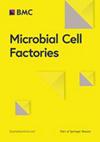热葡糖苷副嗜酸杆菌通过连续热微气泡气体剥离进行乙醇发酵
IF 4.3
2区 生物学
Q1 BIOTECHNOLOGY & APPLIED MICROBIOLOGY
引用次数: 0
摘要
增加使用生物燃料来替代化石燃料,是支持向净零碳排放过渡的战略之一,尤其是在运输领域。然而,由于与粮食使用相冲突,扩大使用第一代作物作为原料是不可持续的。使用植物中的木质纤维素部分和/或食品生产的副产品(包括食品废料)可以满足对生物燃料的需求,而不会影响土地的使用和食品的供应,但能轻易发酵这些原料中所有碳水化合物的生物往往会受到比酵母更严重的生物乙醇抑制作用。本文展示了热气微泡从使用热葡糖酸副嗜热杆菌 TM333 的嗜热发酵过程中剥离乙醇的潜力,从而减少了产品抑制,使生产得以继续进行,超过≤ 2% v/v 的标称有毒乙醇浓度。在实验装置中,细胞以从废弃面包中提取的糖为原料进行分批进行培养,肉汤通过专门设计的微气泡汽提装置不断循环,结果表明,尽管生产率达到相当于 4.7% v/v 的溶解乙醇浓度,但仍能始终保持非/低抑制性溶解乙醇浓度。冷凝液中回收的乙醇浓度适合脱水,具有成本效益,而且不会产生过高的能耗。这表明,热微气泡汽提法可能是一种有价值的技术,可以从发酵过程中连续生产生物乙醇,因为发酵过程在达到经济可行的滴度之前会受到产品抑制,而这正是大多数嗜热乙醇细菌的典型特征。本文章由计算机程序翻译,如有差异,请以英文原文为准。
Ethanologenic fermentation by Parageobacillus thermoglucosidasius with continuous hot microbubble gas-stripping
The increased use of biofuels in place of fossil fuels is one strategy to support the transition to net-zero carbon emissions, particularly in transport applications. However, expansion of the use of 1st generation crops as feedstocks is unsustainable due to the conflict with food use. The use of the lignocellulosic fractions from plants and/or co-products from food production including food wastes could satisfy the demand for biofuels without affecting the use of land and the availability of food, but organisms which can readily ferment all the carbohydrates present in these feedstocks often suffer from more severe bioethanol inhibition effects than yeast. This paper demonstrates the potential of hot gas microbubbles to strip ethanol from a thermophilic fermentation process using Parageobacillus thermoglucosidasius TM333, thereby reducing product inhibition and allowing production to continue beyond the nominal toxic ethanol concentrations of ≤ 2% v/v. Using an experimental rig in which cells were grown in fed-batch cultures on sugars derived from waste bread, and the broth continuously cycled through a purpose-built microbubble stripping unit, it was shown that non/low-inhibitory dissolved ethanol concentrations could be maintained throughout, despite reaching productivities equivalent to 4.7% v/v dissolved ethanol. Ethanol recovered in the condensate was at a concentration appropriate for dewatering to be cost effective and not prohibitively energy intensive. This suggests that hot microbubble stripping could be a valuable technology for the continuous production of bioethanol from fermentation processes which suffer from product inhibition before reaching economically viable titres, which is typical of most thermophilic ethanologenic bacteria.
求助全文
通过发布文献求助,成功后即可免费获取论文全文。
去求助
来源期刊

Microbial Cell Factories
工程技术-生物工程与应用微生物
CiteScore
9.30
自引率
4.70%
发文量
235
审稿时长
2.3 months
期刊介绍:
Microbial Cell Factories is an open access peer-reviewed journal that covers any topic related to the development, use and investigation of microbial cells as producers of recombinant proteins and natural products, or as catalyzers of biological transformations of industrial interest. Microbial Cell Factories is the world leading, primary research journal fully focusing on Applied Microbiology.
The journal is divided into the following editorial sections:
-Metabolic engineering
-Synthetic biology
-Whole-cell biocatalysis
-Microbial regulations
-Recombinant protein production/bioprocessing
-Production of natural compounds
-Systems biology of cell factories
-Microbial production processes
-Cell-free systems
 求助内容:
求助内容: 应助结果提醒方式:
应助结果提醒方式:


